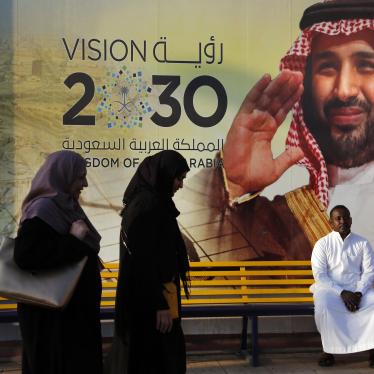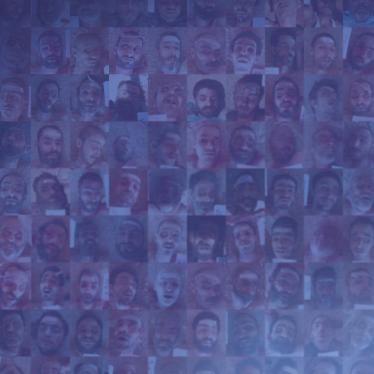(Sanaa) – The previous Yemeni government’s investigation into the so-called Friday of Dignity massacre on March 18, 2011, in Yemen’s capital is marred throughout by flaws and political interference.
The Yemeni authorities should order a new inquiry into the attack, the deadliest by pro-government gunmen on protesters during the 2011 uprising, Human Rights Watch said. The attack in Sanaa killed 45 people and wounded up to 200 others, and became a symbol of resistance to then-president Ali Abdullah Saleh. The criminal trial of 78 defendants in the case is scheduled to begin on September 29, 2012.
“The previous government’s investigation of the Friday of Dignity killings was deeply flawed and may have been a brazen attempt to shield government officials from prosecution,” said Letta Tayler, senior Yemen researcher at Human Rights Watch. “Yemen’s new government should demonstrate its commitment to justice for serious rights abuses by carrying out a new inquiry.”
Among other flaws in the Friday of Dignity investigation, top officials whom witnesses named as suspects were never sought for questioning, including a governor whose Sanaa rooftop was the main staging area for gunmen as they fired at protesters. Six weeks after the attack, Saleh dismissed the general prosecutor after he demanded the arrests of key suspects, including government officials.
Of 78 suspects indicted in June 2011 for the attack, at least 30 remain at large, including the main defendants – a colonel and his brother who then held top security posts. Lawyers for both defendants and victims allege that the authorities made no serious effort to find the suspects. Only 2 of the 14 defendants in pre-trial detention have been charged with intent to kill. Lawyers for the victims have expressed concern that the detained defendants are innocent bystanders or at most peripheral accomplices, and are also seeking a new investigation into the incident.
The killings took place at the southern edge of Change Square, a then-burgeoning anti-Saleh protest camp. As tens of thousands of protesters ended their midday prayer, masked gunmen began shooting at them from the street, trees, and houses including the Sanaa residence of the governor of Mahweet, a governorate northwest of the capital, according to videos and dozens of witnesses who spoke to Human Rights Watch and the media or testified to the authorities.
In the days before the shootings, local residents and Saleh loyalists created a 2.5-meter-high brick wall between the protesters and the gunmen that they drenched with gasoline and set on fire as the attack began, creating clouds of smoke that obscured the shooters and trapped the protesters. Protesters tore the wall down and brutally beat the alleged gunmen, according to video and witness accounts.
Nearly all those killed or wounded were protesters hit by gunfire. Most of the dead were shot in the head or chest. The indictment charges 52 of the defendants with firing gunshots with intent to kill.
Investigators did not question top security force members despite evidence that they failed to protect the protesters, Human Rights Watch said. Various security forces were warned of a possible attack and alerted once it began, yet the Central Security Force, a paramilitary unit that had been deployed on the perimeter of Change Square, had moved away the previous night and failed to return for at least 30 minutes after the shooting began.
The Central Security Forces, who were armed only with batons and a water cannon, stood by with some of the pro-government gunmen in plain sight, according to video, witness testimony to the authorities, and interviews with Human Rights Watch. Some of the gunmen retreated through a line of Central Security forces without being stopped, two witnesses told Human Rights Watch.
Yahya Saleh, the chief of the Central Security Force and former president Saleh’s nephew, told Human Rights Watch in March that there was “no failure” by his forces. He said he sent in forces immediately but that they had only batons and were out-armed by the gunmen.
“The Central Security Forces’ failure to stop the shooting suggests either gross negligence or complicity with the gunmen,” Tayler said. “Yet the General Prosecution never questioned the forces’ chief or investigated their responsibility.
The replacement general prosecutor, Ali Ahmed Nasser al-Awash, who remains in office, denied any meddling by government officials. Any flaws in the case were the result of witnesses and victims’ relatives refusing to cooperate with the investigation, he told Human Rights Watch. Al-Awash acknowledged that the suspects included security force members but said he did not know how many. Lawyers for the victims allege primary defendants are security force members, government officials or members of Saleh’s General People’s Congress party.
Human Rights Watch’s findings about the investigation, to be published in an upcoming report, are based on a review of the indictment, which includes nearly 1,000 pages of testimony; examinations of more than 20 videos of the attack; and interviews with more than three dozen people with knowledge of the case. Those interviewed include witnesses, lawyers for defendants and victims, government officials, and Yemeni and international journalists who were at the scene.
Accountability for the attacks is also complicated by a law the Yemeni parliament passed in January in exchange for Saleh’s resignation, which grants the former president and all those who served with him sweeping immunity from prosecution for any crimes committed during his 33-year rule. Lawyers for victims have vowed to challenge the immunity law if it is applied to defendants who are members of the security forces or other government offices.
In September, transition President Abdu Rabu Mansour Hadi signed a decree authorizing the creation of an independent and impartial commission adhering to international standards to investigate human rights violations during the 2011 uprising. However, even if the panel were to call for prosecutions, there is a risk that the recommendation might not apply to government officials because of the immunity law.
While Hadi’s decree is an important step, a new criminal investigation into the Friday of Dignity attack is needed regardless of the commission of inquiry timetable, Human Rights Watch said. Human Rights Watch reiterated its call for Yemeni authorities to repeal the immunity law, which violates Yemen’s international legal obligations to prosecute serious violations of human rights.
“The new government’s moves to create a commission of inquiry are critically important,” Tayler said. “But they should not be seen as a substitute for prosecuting those responsible for serious crimes.”
For more information about the sequence of events during the attack and the earlier investigation, and more details about flaws in the proceedings and testimony from victims, please see the below text.
A Pivotal Attack
The Friday of Dignity massacre became one of the pivotal events in the uprising against Saleh, prompting a national and international outcry and resulting in dozens of defections of government officials including a top military commander, Gen. Ali Mohsen al-Ahmar. Three days after the attack, al-Ahmar joined the opposition and deployed his powerful First Armored Division to guard the Change Square protesters. Saleh agreed to leave office in November 2011 and formally ceded power three months later to his longtime vice president, Abdu Rabu Mansour Hadi.
Protesters responded to the Friday of Dignity shootings by throwing rocks and bricks at the gunmen, tearing down the wall that separated them and storming buildings, including the Mahweet governor’s residence, where many of the gunmen were deployed, according to video footage and numerous witnesses. The protesters set the governor’s house on fire and captured at least 14 alleged gunmen and other suspects, many of whom they brutally beat, several witnesses said.
A security committee at Change Square interrogated the suspects – harshly, according to the suspects’ lawyers – and turned them over to the headquarters of the First Armored Division of the Yemeni army, about a kilometer away. Four of the 14 original suspects were among those indicted; the others were released.
Dismissals and Failure to Question
President Saleh declared a 30-day state of emergency immediately after the attack. He removed Prosecutor General Abdullah al-Ulofy from office on April 28, 2011. In the preceding weeks, al-Ulofy had called on security forces to protect the protesters, criticized the state of emergency, ordered all 14 detained suspects to remain jailed pending further investigations, and, according to an interview he gave to a regional newspaper, threatened to resign if the top suspects, who included government officials, were not arrested.
Three months after the attack, on June 29, Judge Ali Saeed al-Samet, the chief prosecutor on the case, presented his indictment to the First Instance Criminal Court for the Western Capital District naming 78 defendants. Thirty of them – including nearly all primary defendants – were listed as being at large.
Lawyers for defendants and victims alleged the prosecution had indicted suspects almost arbitrarily to obscure the fact that the key defendants were missing. The court immediately released 34 suspects for lack of evidence. Many of those 34 defendants also appear to have gone into hiding: during a pre-trial hearing in September, only seven defendants appeared in court.
The indictment dropped charges against 59 suspects, including Mahweet Governor Ahmed Ali Mohsen al-Ahwal. Al-Ahwal’s sons are two key suspects who remain at large. The rooftop of the governor’s home in Sanaa, about 30 meters south of the wall, was a principal location from which the gunmen fired. A guard at a building near the attack testified to the authorities that he threw rocks at the protesters because the governor had told him to attack the demonstrators. Another witness testified that the governor commissioned construction of the wall. The governor was never questioned.
The governor’s son Ali Ahmed Ali Mohsen al-Ahwal, a colonel who was then the director of Yemen’s powerful Criminal Investigation Division and is the primary suspect, allegedly was shooting a gun from the governor’s rooftop, the indictment says, based on testimony from witnesses. He and his brother Ghazi Ahmed Ali Mohsen al-Ahwal are among those charged with intent to kill.
One defendant’s testimony suggests that Ali al-Ahwal was among those initially apprehended by the authorities, although there is no record of his being questioned or held. The defendant testified that he saw Ali al-Ahwal among the group of alleged gunmen who had been transferred to a military jail at the First Armored Division the afternoon of the attack.
On March 26, 2011, the opposition Ain News website posted what it claimed was a memo bearing the presidential seal and Saleh’s signature, informing the Interior Ministry that any effort by the General Prosecution to question the Mahweet governor, his son or their guards should be “frozen.” The Saleh government never denied issuing the memo. A spokesman for the current Yemeni government told Human Rights Watch that it was unable to confirm or deny the memo’s authenticity and that for such questions a national commission of inquiry was “crucial to sort the facts from the lies.”
Other Questionable Aspects of the Probe
Lawyers and others raised additional concerns with Human Rights Watch about the authorities’ handling of the case:
-
Several defendants were initially questioned as witnesses and received notice that they were indicted the day they were charged, their lawyers said. The Yemeni legal system requires prosecutors to give suspects an opportunity to rebut charges before they are formally indicted, but the short notice prevented that.
-
Elham Sharaf Abu Taleb, the mother of one suspect, told Human Rights Watch that when she went to the prosecutor’s office to inquire about her son, an official there asked her to place her fingerprint on a piece of paper to help gain his release. Taleb complied but said she cannot read and did not know what the paper said. Later, Taleb said, she learned that the paper was testimony falsely stating that she had seen another suspect, who came from a prominent pro-Saleh family, heading toward the wall on the day of the attack with a gun. Taleb told Human Rights Watch she had only seen the man standing with her son and others at a market.
-
Lawyers for the victims as well as the accused assert that of the 14 defendants held in pre-trial detention, most are innocent and only remain behind bars because they lack clout. While 8 of the 14 are accused of shooting a firearm with the intent to kill, only two are key suspects and the rest are charged as accomplices. One of those jailed is Khaled Saeed Ahmed Batarfi, a 65-year-old garbage collector whom soldiers arrested about a kilometer from the attack because he was carrying a rag that had been wet with a flammable substance such as that used to set fire to the wall. In a jailhouse interview, Batarfi told Human Rights Watch that he used the substance for cleaning.
-
Another jailed suspect, who has been detained since July 2011, is a homeless man who contends that his is a case of mistaken identity. Like many Yemenis, he lacks identification papers. During a jailhouse interview with Human Rights Watch, the man said his name was Muammar Ali Hussein al-Hout, not Muammar Nagi Ali al-Hout, the name of a defendant in the Friday of Dignity case. Al-Hout freely admitted he had been living in a tent camp for pro-Saleh protesters and said he had been jailed for drinking and stabbing a man who tried to steal his money and cellphone. When al-Hout was brought to court weeks later for what he thought would be a sentence of 80 lashes for that incident, the judge unexpectedly returned him to jail as one of the shooters, he and his lawyers said.
-
The General Prosecution’s case summary includes allegations from witnesses that an officer in the First Armored Division, Maj. Abdullah al-Mikhlafi, led a group of gunmen who fired at protesters from atop a honey store near the wall. The indictment said investigators were unable to find out if the gunman was al-Mikhlafi, although he is a well-known figure and the General Prosecution never brought him in for a lineup or questioning.
- Lawyers showed Human Rights Watch numerous errors in the indictment file, some of them substantive. Many names of witnesses or suspects are incomplete or incorrect, including the name of one of the key defendants, the governor’s son Ghazi Ahmed Ali Mohsen al-Ahwal. Instead, the charge sheet lists a similar name that the defendants’ lawyers say is that of Ghazi al-Ahwal’s 10-year-old son. The list of 127 wounded includes at least four people who testified that they were not wounded on that day but instead during other attacks on protesters. Five other wounded appear to be listed at least twice but with slight variations to their names. A motion filed by lawyers for the defendants alleging that the final page of testimony was fraudulently inserted is pending in a Sanaa appeals court.
Quotes from Witnesses and Others in the Friday of Dignity Case
A very close friend of mine, Ali al-Salahi, was killed. He was 23. He was standing near the wall. On the way to the wall I saw him alive. On the way back to the wall I saw him dead. It looked like a big machine gun shot him. Later I saw footage from Suhail TV of the pool of blood coming from his body and another protester putting his hands in his blood and putting that blood on his chest. Ali al-Salahi was a newlywed. He had just furnished an apartment for his new family but he never got to live in it.
–Khahil Qaed Mohammed al-Mulaiky, 25, protester and vice principal of a private school
The prosecutor . . . asked me to put my fingerprint on a paper and said this will help free my son, so I did. I still don’t know what was on that paper because I can’t read or write. Later, I learned that the prosecutor said that I told him that I saw Basem [suspect Basem Abdulghani Mohammed Hamoud al-Harethi, a member of a prominent Yemeni family] holding a weapon and heading toward the place where everything happened. I have never seen him holding a weapon. He was standing right around the corner with my sons and others near the qat market, that’s all.
–Elham Sharaf Abu Taleb, the mother of suspect Ayman Yahya Badr, 19
That morning, he took a shower and put on cologne and went to the square. I cooked him lunch but he never came back. . . .We want a fair trial, not compensation.
–Zainab Ahmed Moad Salah, mother of shooting victim Salah Abdullah al-Shurmani, 22







